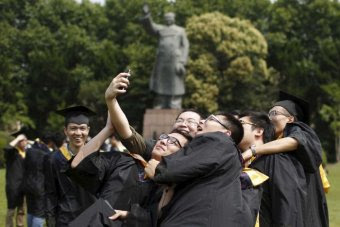
Photo: Chinese graduates pose in front of a statue of late Chinese leader Mao Zedong in Shanghai (Reuters: Aly Song)
Chinese graduates are not too concerned by the slower economic growth that the country is experiencing.
Over the past four years, Zhou Yueliang has employed 15 final year university students as part of his company's graduate intake program in Changsha, Hunan.
Hunan is a major rice producing province in south central China.
Mr Zhou's company Hengniu is in the business of researching and selling high-yielding rice varieties.
They are currently trialling the production of this rice in more than 10 countries including Cambodia, Laos and the Philippines.
Exports are expected to begin to at least two markets next year.
However, Mr Zhou finds it difficult to attract and retain these new employees despite the prospects and the abundance of fresh graduates — nearly 7.5 million this year.
The study and development of rice seeds requires expertise in areas such as soil and plant protection.
It also needs patience that many do not have because sometimes years of research yields little.
There is also a perception that agriculture belongs to the history books of Hunan and the rest of China.
"Most of the students who major in agriculture at university come from the countryside," he said.
"Their parents send them to university in the hope they leave this industry. Many people object if these students remain in the sector."
Changing priorities among younger Chinese
The record number of graduates entering the workforce of the world's second largest economy represents almost a third of Australia's population.
This year's figure is an increase of 220,000 from last year.
Given the huge pressure the added supply places on jobs, there are worries the class of 2015 will find it more difficult gaining employment as the economy slows.
State media reports said companies had reduced their graduate intake because the good times are fading.
But rising unemployment does not seem to be a problem in Changsha.
Official unemployment figures around the country are a touch over 4 per cent, well below the target of 4.5 per cent.
"I was hired at a campus recruitment fair. My classmates and I are all employed because it's easier with our major in finance," said one recent graduate.
"It's more difficult for others like those who major in music and the arts."
If you keep doing a job you do not like then I think there's no meaning to life.
Recent graduate, Mr Liu
What was noticeable is that the priorities of this latest generation of young Chinese workers have changed. They value job satisfaction over job security.
A 22-year-old finance graduate present at a career fair in Changsha was on the hunt for a new job after working in his current position for only two months.
The man who would only identify himself as Mr Liu draws a monthly salary of around $661, what most people in Changsha get at an entry level.
The graduates said it is enough to live on in a small city like Changsha, where the cost of living is significantly lower than in Beijing.
An apartment in Changsha costs about a fifth of one in the Chinese capital.
"You have to do something you are interested in because time flies," Mr Liu said. "If you keep doing a job you do not like then I think there's no meaning to life."
Even those pursuing careers in sectors affected by the global economic downturn like energy and commodities don't always jump at the first opportunity.
Li Yanlong, 26, majored in mining and rejected one offer before finally saying yes six months later.
He was offered the same starting salary as those who graduated a few years ago.
"I didn't like the idea of joining that company and believed I could do better," Mr Li said. "But I became increasingly anxious as I continued looking. My job search took me to many cities including Beijing."
The stage could be set for a clash of generations between younger Chinese workers and their bosses to be as priorities and expectations change.
Employers like Mr Zhou complain local universities are not equipping graduates with practical skills and lament that the current generation of workers lacks direction and drive.
"After these students graduate they must recognise they should contribute to society before they get something in return," he said while urging them to change their perspective.
"They cannot depend on handouts from the boss."
Source - abc.net.au



